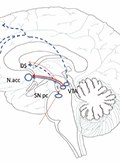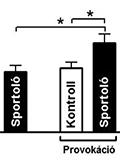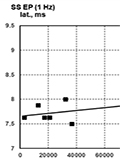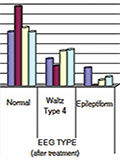The eLitMed.hu medical portal uses computer cookies for convenient operation. Detailed information can be found in the Cookie-policy.
Clinical Neuroscience - 2018;71(01-02)
Content
[Clinical neurophysiological methods in diagnosis and treatment of cerebrovascular diseases]
[Neurophysiological methods are gaining ground in the diagnosis and therapy of cerebrovascular disease. While the role of the EEG (electroencephalography) in the diagnosis of post-stroke epilepsy is constant, quantitative EEG para-meters, as new indicators of early efficiency after thrombolysis or in prognosis of patient’s condition have proved their effectiveness in several clinical studies. In intensive care units, continuous EEG monitoring of critically ill patients became part of neurointenzive care protocols. SSEP (somatosesnsory evoked potencial) and EEG performed during carotid endarterectomy, are early indicative intraoperativ neuromonitoring methods of poor outcome. Neurorehabilitation is a newly discovered area of neurophysiology. Clinical studies have demonstrated the effectiveness of repetitive transcranial magnetic stimulation (rTMS) in the rehabilitation of stroke patients. Brain computer interface mark the onset of modern rehabi-litation, where the function deficit is replaced by robotic tehnology. ]
Insights into the structure and function of the hippocampal formation: Relevance to Parkinson’s disease
The link between the hippocampus and declarative memory dysfunctions following the removal of the medial temporal lobe opened unexplored fields in neuroscience. In the first part of our review, we summarized current theoretical frameworks discussing the role of hippocampus in learning and memory. Several theories are highlighted suggesting that the hippocampus is responsible for assembling stimulus elements into a unitary representation that later can be utilized to simulate future events. The hippocampal formation has been implicated in a growing number of disorders, from neurodegenerative diseases to atypical cognitive ageing and depression. Recent neuroimaging studies provided new opportunities to study in detail the hippocampal formation’s role in higher levels of the nervous system. We will present data regarding the regional specialization of the hippocampus in experimental models developed for healthy and neurological conditions with a special focus on Parkinson’s disease. Combined evidence from neuroimaging studies suggested that hippocampal volume is reduced in non-demented, newly diagnosed patients with Parkinson’s disease, which is associated with impaired memory performance. These findings proposed that, beyond the well-known striatal dopamine loss, impaired hippocampal synaptic plasticity may contribute to cognitive and affective impairments in early Parkinson’s disease.
[Effects of nasal provocation with a single-dose allergen on the explicit and implicit memory of physically active and inactive patients with ragweed allergy]
[Background and purpose - Allergy is an endemic disease and has a considerable impact on the quality of life. This study aimed to measure the effect of active allergic rhinitis on memory functions of physically active and inactive patients with ragweed allergy. Methods - Memory functions were assessed before and after allergen exposure. Participants in both groups were provoked nasally with 30 IR/mL ragweed allergen in each nostril. Explicit memory was measured with story-recalling and implicit memory was investigated with reaction time task. Results - In neuropsychological assessments athletes performed significantly better, compared with the control group after allergen provocation in short-term and long-term memory functions. There was no difference between the groups in the implicit tasks. Athletes have achieved better results after provocation, comparing to the baseline test and the tests that measured short-term and long-term memory functions. Conclusion - Short-term disturbing factors, e.g. swollen nasal mucosa, sneezing, and watery eyes after provocation did have not caused deterioration in cognitive functions. A single-shot allergen in high doses have caused an increase of mental concentration, which was more pronounced in athletes.]
Functional neurotoxicity and tissue metal levels in rats exposed subacutely to titanium dioxide nanoparticles via the airways
Introduction and aims - Nanoparticles of titanium dioxide are suspected neurotoxic agents and have numerous applications possibly resulting in human exposure by several ways including inhalation. In the present work, rats were exposed to spherical TiO2 nanoparticles of two different sizes by the intratracheal route. It was investigated how the neuro-functional alterations, detected by electrophysiological and behavioral methods, were related to the concentration of Ti in the tissue samples and what the influence of the size of the NPs was. Materials and methods - Rats (young adult Wistar males, 10/group) were exposed to TiO2 nanoparticles of ca. 10 and 100 nm diameter (suspension medium: neutral PBS with 1% hydroxyethyl cellulose) by intratracheal instillation in 5 and 18 mg/kg b.w. dose; 5 days per week for 6 weeks. Controls were instilled with saline, and vehicle controls, with the suspension medium. To see general toxicity, body weight was checked daily, and organ weights were measured at the end of experiment. Grip strength test, to assess motor function damage, was done before and after the 6-week treatment. Finally, the rats were anesthetized with urethane, spontaneous cortical activity and sensory evoked potentials were recorded, then the rats were dissected and tissue samples were taken for Ti level measurement. Results - Body weight gain indicated no general toxicity, and no significant change in the relative organ weights, except that of the lungs, was seen. However, change of time-to-fall in the grip strength test, and latency of cortical evoked potentials, were altered in the treated groups, indicating functional damage. Correlation of these alterations with the cortical Ti level was dissimilar for the two sizes of nanoparticles. Conclusion - The results provided further support to the functional neurotoxicity of TiO2 nanoparticles. The exact role of particle size, and the mechanisms involved, remain to be elucidated.
Electroclinical and prognostic characteristics of epilepsy patients with photosensitivity
Background - Epilepsy with photosensitivity (PSE) is one of the reflex epilepsy types with pathophysiology still unexplained. In our study we aimed to evaluate the clinical, electroencephalogram (EEG) and prognosis of patients with PSE diagnosis. Method - A total of 44 patients with PSE diagnosis according to international classification were included in this retrospective and cross-sectional study. The age, gender, syndrome, clinical and EEG characteristics of patients, and treatment response were investigated. Results - The mean age was 22.09±6.49 years for 28 females and 16 males included in the study. Of patients, 17 had idiopathic photosensitive occipital lobe epilepsy (IPOLE), 11 had juvenile myoclonic epilepsy (JME), 11 had other PSE and 5 had juvenile absence epilepsy (JAE), with the most common visual trigger factors television and sunlight. In terms of seizure type, the most common was generalized tonic clonic seizure (GTCS), with myoclonus, absence and other seizure types observed. There was family history present in 17 patients and valproic acid was most commonly used for treatment. Conclusion - As noted in the literature, our data show that PSE has defined age group and clinical presentation, good prognosis but requires correct choice of medication for treatment. It is thought that good description of these epilepsy types will reduce misdiagnosis and mistreatment rates.
Alteration of mean platelet volume in the pathogenesis of acute ischemic stroke: cause or consequence?
Introduction - Platelets have a crucial role on vascular disease which are involved in pathogenesis of ischemic stroke. Platelet size is measured as mean platelet volume (MPV) and is a marker of platelet activity. Platelets contain more dense granules as the size increases and produce more serotonin and tromboglobulin (b-TG) than small platelets. In this study, the alteration of MPV values were investigated in patients with acute stroke, who had MPV values before stroke, during acute ischemic stroke and 7 days after the stroke. The relationship between this alteration and risk factors, etiology and localization of ischemic stroke were also investigated. Methods - Sixty-seven patients with clinically and radiologically established diagnoses of ischemic stroke were enrolled into the study and stroke etiology was classified by modified Trial of Org 10 172 in Acute Stroke Treatment (TOAST) classification and, modified Bamford classification was used for localization and stroke risk factors were also evaluated. The platelet counts and MPV values from patient files in patients who had values before stroke (at examination for another diseases), within 24 hours of symptom onset and after 7 further days were analysed. Results - MPV values increased after stroke (10.59±2.26) compared with acute stroke values (9.84±1.64) and the values before stroke (9.59±1.72) (p<0.0001); this alteration of MPV values occured 7 days after stroke (p<0.016). There was a positive correlation between age and MPV values during acute stroke (r=0.270; p<0.05). Patients with atrial fibrillation had higher alteration in the time of MPV compared with patients without atrial fibrillation (p>0.006). We assessed for gender, men (n=38) had a higher alteration in the time of MPV compared with women (n=29) (p=0.013). Conclusion - Although there was no alteration of platelet counts, MPV values were increased 7 days after stroke in patients with acute ischemic stroke.
Association of cardiovascular risk factors and Parkinson’s disease - case-control study in South East Hungary
Aims - Parkinson’s disease (PD) has the second highest incidence among neurodegenerative diseases in the world population. The study aimed to investigate the presence of some cardiovascular risk factors - dyslipidemia, diabetes, and hypertension - in PD patients and to compare their risk with non-PD population in South East Hungary. Methods - A case-control study was conducted at the Department of Neurology, University of Szeged, Hungary. The study included 1299 subjects out of which 620 patients were identified as cases of diagnosed PD and 679 as controls. Logistic regression analyses were conducted to reveal the association of vascular risk factors with PD. Results - In the univariate analysis, diabetes mellitus was positively associated with PD, while dyslipidemia showed negative association to it in the total population, and no significant associations were found between hypertension and PD. The multivariate logistic regression models showed that the odds of diabetes mellitus was higher (OR=2.86), while the odds of dyslipidemia was lower (OR=0.58) among PD patients than in the control group. Hypertension showed a different pattern by gender: the odds of registered hypertension was significantly lower in female PD patients (OR=0.68), whereas the result was not significant in males. Conclusions - This is the first study that provides a comprehensive view of the cardiovascular risk factors in PD patients in Hungary and shows considerable relationship between diabetes mellitus and PD.
[The facets of creativity in the light of bipolar mood alterations]
[The link between creativity, as the highest expression form of human achievement, and bipolar disorder came into focus of scientific investigations and research. Accomplished writers, composers and visual artists show a substantially higher rate of affective disorders, prodominantly bipolar mood disorders, comparing to the general population. Then again, patients afflicted with bipolar II subtype (hypomania and depression), as well as persons presenting the mildest form of bipolar mood swings (cyclothymia) possess higher creative skills. It evokes therefore that certain forms and mood states of bipolar disorder, notably hypomania might convey cognitive, emotional/affective, and motivational benefits to creativity. The aim of this paper is to display expression forms of creativity (writing, visual art, scientific work) as well as productivity (literary and scientific work output, number of artworks and exhibitions, awards) in the light of clinically diagnosed mood states at an eminent creative individual, treated for bipolar II disorder. Analysing the affective states, we found a striking relation between hypomanic episodes and visual artistic creativity and achievement, as well as scientific performance, whereas mild-moderate depressed mood promoted literary work. Severe depression and mixed states were not associated with creative activities, and intriguingly, long-term stabilised euthymic mood, exempted from marked affective lability, is disadvantageous regarding creativity. It seems, thereby, that mood functions as a sluice of creativity. Nevertheless, it is likely that there is a complex interaction between bipolar mood disorder spectrum and psychological factors promoting creativity, influenced also by individual variability due to medication, comorbid conditions, and course of disorder.]
1.
Clinical Neuroscience
Is there any difference in mortality rates of atrial fibrillation detected before or after ischemic stroke?2.
Clinical Neuroscience
Factors influencing the level of stigma in Parkinson’s disease in western Turkey3.
Clinical Neuroscience
Neuropathic pain and mood disorders in earthquake survivors with peripheral nerve injuries4.
Journal of Nursing Theory and Practice
[Correlations of Sarcopenia, Frailty, Falls and Social Isolation – A Literature Review in the Light of Swedish Statistics]5.
Clinical Neuroscience
[Comparison of pain intensity measurements among patients with low-back pain]1.
2.
Clinical Neuroscience Proceedings
[A Magyar Stroke Társaság XVIII. Kongresszusa és a Magyar Neuroszonológiai Társaság XV. Konferenciája. Absztraktfüzet]3.
4.
Journal of Nursing Theory and Practice
[A selection of the entries submitted to the literary contest "Honorable mission: the joys and challenges of our profession" ]5.
Journal of Nursing Theory and Practice
[End of Life and Palliative Care of Newborns in the Nursing Context]









